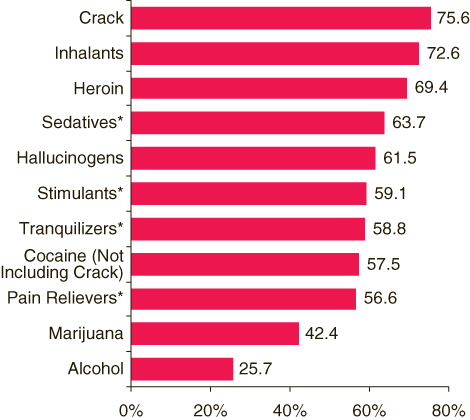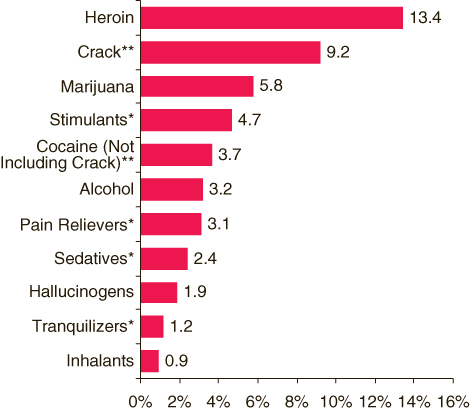
 |
| March 27, 2008 |
|
Among year-before-last initiates of specific substances, over two thirds of crack cocaine, inhalant, and heroin initiates did not use the drug in the past year (Figure 1). Alcohol and marijuana were the only substances for which the majority of year-before-last initiates used the substance in the past year.
 |
| Substance | Percent |
|---|---|
| Crack | 75.6% |
| Inhalants | 72.6% |
| Heroin | 69.4% |
| Sedatives* | 63.7% |
| Hallucinogens | 61.5% |
| Stimulants* | 59.1% |
| Tranquilizers* | 58.8% |
| Cocaine (Not Including Crack) | 57.5% |
| Pain Relievers* | 56.6% |
| Marijuana | 42.4% |
| Alcohol | 25.7% |
| Source: SAMHSA, 2004-2006 NSDUHs. |
Among year-before-last initiates of alcohol, one fourth (25.7 percent) had not used alcohol during the past year, 71.1 percent had used alcohol in the past year but were not dependent on alcohol, and 3.2 percent were both using and dependent on alcohol during the past year (Table 1).
| Substance | No Use in Past 12 Months |
Use in Past 12 Months but Not Dependent |
Use in Past 12 Months and Dependent in Past 12 Months |
|||
|---|---|---|---|---|---|---|
| % | SE | % | SE | % | SE | |
| Alcohol | 25.7% | 0.54 | 71.1% | 0.56 | 3.2% | 0.23 |
| Marijuana | 42.4% | 0.87 | 51.8% | 0.86 | 5.8% | 0.36 |
| Cocaine Use | ||||||
| Cocaine (Not Including Crack)** | 57.5% | 1.63 | 38.8% | 1.61 | 3.7% | 0.54 |
| Crack** | 75.6% | 3.06 | 15.2% | 2.83 | 9.2% | 1.69 |
| Heroin | 69.4% | 3.87 | 17.2% | 3.21 | 13.4% | 2.59 |
| Hallucinogens | 61.5% | 1.25 | 36.6% | 1.24 | 1.9% | 0.32 |
| Inhalants | 72.6% | 1.22 | 26.5% | 1.21 | 0.9% | 0.25 |
| Nonmedical Use of Psychotherapeutics* | ||||||
| Pain Relievers | 56.6% | 1.16 | 40.2% | 1.14 | 3.1% | 0.33 |
| Tranquilizers | 58.8% | 1.69 | 40.0% | 1.69 | 1.2% | 0.37 |
| Stimulants | 59.1% | 1.76 | 36.2% | 1.70 | 4.7% | 0.87 |
| Sedatives | 63.7% | 4.27 | 33.9% | 4.26 | 2.4% | 1.05 |
| Source: SAMHSA, 2004-2006 NSDUHs. |
Among year-before-last initiates of marijuana, 42.4 percent had not used marijuana during the past year, 51.8 percent had used marijuana in the past year but were not dependent on marijuana, and 5.8 percent were both using and dependent on marijuana in the past year.
Year-before-last initiates of cocaine were examined in two subgroups: initiates of crack and initiates of cocaine other than crack. Approximately 9.2 percent of year-before-last crack initiates were dependent on any type of cocaine in the past year, whereas 3.7 percent of initiates of cocaine other than crack were dependent on any type of cocaine in the past year (Figure 2).
 |
| Substance | Percent |
|---|---|
| Heroin | 13.4% |
| Crack** | 9.2% |
| Marijuana | 5.8% |
| Stimulants* | 4.7% |
| Cocaine (Not Including Crack)** | 3.7% |
| Alcohol | 3.2% |
| Pain Relievers* | 3.1% |
| Sedatives* | 2.4% |
| Hallucinogens | 1.9% |
| Tranquilizers* | 1.2% |
| Inhalants | 0.9% |
| Source: SAMHSA, 2004-2006 NSDUHs. |
More than one tenth (13.4 percent) of year-before-last initiates of heroin were dependent on heroin in the past year, while less than 1 percent (0.9 percent) of year-before-last inhalant initiates were dependent on inhalants in the past year and less than 2 percent (1.9 percent) of year-before-last hallucinogen initiates were dependent on hallucinogens in the past year. About 5 percent (4.7 percent) of year-before-last initiates of nonmedical use of stimulants were dependent on stimulants in the past year, whereas in the past year, 3.1 percent of year-before-last initiates of nonmedical pain reliever use were dependent on pain relievers, 2.4 percent of initiates of nonmedical sedative use were dependent on sedatives, and 1.2 percent of initiates of nonmedical tranquilizer use were dependent on tranquilizers.
| The National Survey on Drug Use and Health (NSDUH) is an annual survey sponsored by the Substance Abuse and Mental Health Services Administration (SAMHSA). The 2004 to 2006 data used in this report are based on information obtained from 203,870 persons aged 12 or older. The survey collects data by administering questionnaires to a representative sample of the population through face-to-face interviews at their place of residence. The NSDUH Report is prepared by the Office of Applied Studies (OAS), SAMHSA, and by RTI International in Research Triangle Park, North Carolina. (RTI International is a trade name of Research Triangle Institute.) Information on NSDUH used in compiling data for this report is available in the following publication: Office of Applied Studies. (2007). Results from the 2006 National Survey on Drug Use and Health: National findings (DHHS Publication No. SMA 07-4293, NSDUH Series H-32). Rockville, MD: Substance Abuse and Mental Health Services Administration. Information for earlier NSDUHs is available in the following publications: 2005 NSDUH: (DHHS Publication No. SMA 06-4194, NSDUH Series H-30) 2004 NSDUH: (DHHS Publication No. SMA 05-4062, NSDUH Series H-28) Also available online: http://oas.samhsa.gov. Because of improvements and modifications to the 2002 NSDUH, estimates from the 2002 through 2006 surveys should not be compared with estimates from the 2001 or earlier versions of the survey to examine changes over time. |
| The NSDUH Report is published periodically by the Office of Applied Studies, Substance Abuse and Mental Health Services Administration (SAMHSA). All material appearing in this report is in the public domain and may be reproduced or copied without permission from SAMHSA. Additional copies of this report or other reports from the Office of Applied Studies are available online: http://oas.samhsa.gov. Citation of the source is appreciated. For questions about this report, please e-mail: shortreports@samhsa.hhs.gov. |
|
This page was last updated on December 30, 2008. |
|
SAMHSA, an agency in the Department of Health and Human Services, is the Federal Government's lead agency for improving the quality and availability of substance abuse prevention, addiction treatment, and mental health services in the United States. 
* PDF formatted files require that Adobe Acrobat Reader® program is installed on your computer. Click here to download this FREE software now from Adobe. |